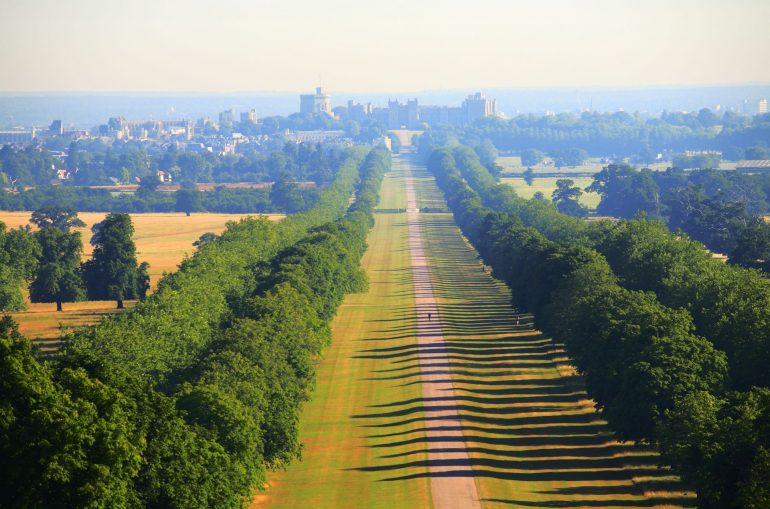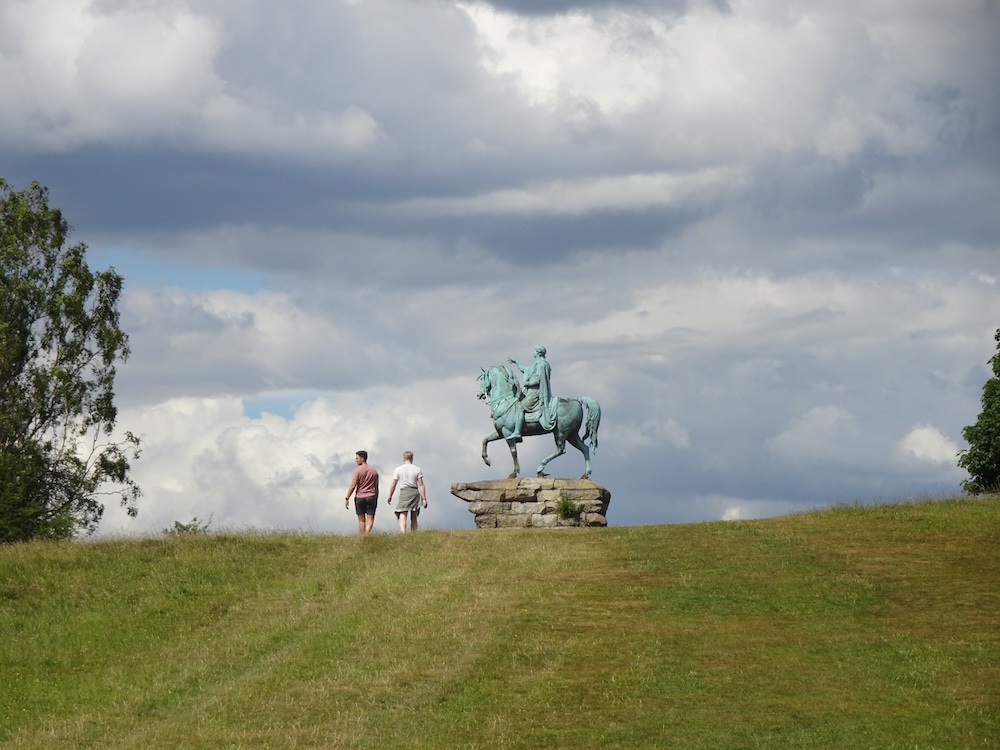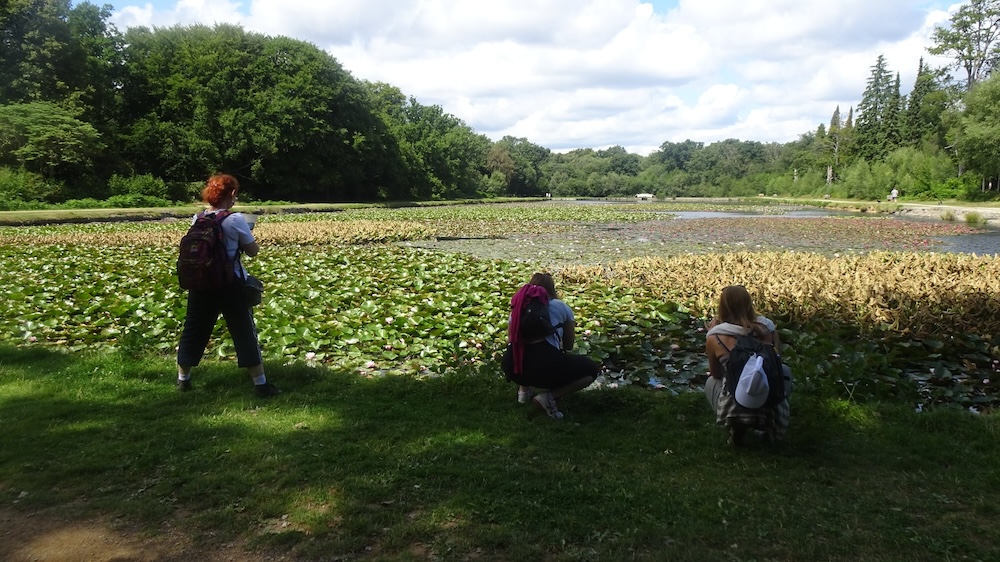If you are in London and planning a trip to Windsor Castle, why not make it a full day and include a visit to Windsor Great Park? In 2021, the park was crowned the UK’s most popular free attraction. This ancient Royal landscape of forests, lakes, and gardens really deserves a visit. It boasts over 1,000 years of history, monuments and rare wildlife, a national collection of plants, champion trees, a farm, vineyard, and forest.
 The Long Walk towards Windsor Castle in the distance. Photo Credit: © Visit Britain / Pawel Libera.
The Long Walk towards Windsor Castle in the distance. Photo Credit: © Visit Britain / Pawel Libera.
History of Windsor Great Park
Throughout the centuries, Windsor Great Park has been several things. These include:
Royal Hunting Ground:
William the Conqueror not only started to build Windsor Castle, but he also created a larger hunting enclosure that supplied the castle with wood, deer, boar, and fish.
Marketplace:
During the nineteenth and early twentieth centuries, one of the main events for farmers was the Christmas sale of stock from the Royal Windsor Estates. Buyers came from all over the country to buy something from the monarch.
Airport:
From the 1920s to the 1950s, Smith’s Lawn in Windsor Great Park was used for flying. Prince Philip made his first solo flight there in 1952.
Public Park:
It wasn’t until after the Second World War that Windsor Great Park became a recreation area and opened to the public.
And a haunted one…
If you walk in Windsor Great Park after dusk, look out for the ghost of Herne the Hunter, a spirit with antlers riding an ethereal black horse. He was one of the keepers of Windsor Forest during the reign of Richard II. The story has it that he once rescued the king from being injured by a stag but was fatally wounded in the process. A strange spirit came along and revived him by attaching the stag’s antlers to his head!
Wildlife and Nature:
The Windsor Estate provides habitats for a vast array of fauna and flora. Woodlands, parklands, grasslands and heathlands, lakes and wetlands and incredibly rich wildlife with birds, bats, insects, fish, and rare fungi and lichens. Some fun facts:
Red Deer
They are the stars of the show! Prince Philip established the current herd of red deer within Windsor Great Park with forty hinds from the Balmoral Estate.
Queen Executioner Beetle
An endangered species in the United Kingdom, Queen’s executioner are believed to be restricted to Windsor Great Park. Where does the name come from? In 2010, The Guardian launched a competition to mark the International Year of Biodiversity in collaboration with Natural England and the Oxford University Museum of Natural History. The winning creator gave the following rationale for his choice of name: “I’ve gone with this for the link to Windsor and the royals. The executioner is to represent that it kills (and eats) the larvae of others and links to its black colour.” (The hood of an executioner is traditionally black).
 The Copper Horse in Windsor Great Park. Photo Credit: © Ildi Pelikan.
The Copper Horse in Windsor Great Park. Photo Credit: © Ildi Pelikan.
Favourite places in Windsor Great Park:
Statue of King George III
Standing over the iconic view of Snowhill is a famous copper horse statue depicting King George III, who was the first monarch to die at Windsor Castle. Inspired by the equestrian statue of the emperor Marcus Aurelius in Rome, it was ordered a year after the king’s death by his son George IV and shows George III in the style of a Roman emperor wearing a laurel wreath and toga and riding without stirrups. He is pointing towards his favourite residence, Windsor Castle. The inscription on the base reads: Georgio Tertio / Patri optimo / Georgius Rex, which translates as: ‘To George the Third, the best of fathers, King George IV.’ However, like so many father son relationships in the Hanoverian family, George III and George IV were known to have despised one another. From Snowhill, there are breathtaking views of the long walk stretching almost two and a half miles to Windsor Castle.
Queen Anne’s Ride
Queen Anne’s Ride is a 2.9-mile ‘avenue’ between Windsor Great Park and Ascot Heath. First mentioned in 1708, it provided Queen Anne’s horse-drawn carriage (or ‘chaise’) with easy access to the Great Park and forest beyond. Hunting was Anne’s favourite sport, and she frequently went out to Windsor Great Park, then known as Windsor Forest. Once, while out riding, Queen Anne noticed the potential of the open heathland around Ascot, not more than five miles from the castle, and thought it would be ideal for “horses to gallop at full stretch”. Later, in 1711, she founded the world-famous Royal Ascot Racecourse.
Cow Pond
Cow Pond is a serene ornamental lake created in the 1700s. It is a beautiful place to walk, take photographs or simply enjoy the outside air. Initially designed by the architect Henry Flitcroft, Cow Pond underwent extensive renovation in 2012 to commemorate Queen Elizabeth II’s Diamond Jubilee and is full of waterlilies.
Cumberland Lodge
Built in the seventeenth century, Cumberland Lodge became the official residence of the Ranger of the Great Park after a restoration by Charles II. Famous rangers have included Sarah Churchill, the Duchess of Marlborough, once a dear friend of Queen Anne (until they fell out during an argument at Kensington Palace), Prince Philip, who was the longest-serving Ranger of Windsor Great Park and became affectionately known to the estate workers as simply ‘The Duke’. The current ranger is no other than King Charles III. He is the greenest-fingered monarch in Britain’s history and is known for his care and love for the environment.
George VI Coronation Plantation
As you walk from Cumberland Lodge to Cow Ponds, you will see oak trees. It was King George VI, the late Queen Elizabeth II’s father, who planted the first of sixty oak trees Twenty different species were planted by representatives from fifty-nine Commonwealth countries and are placed in positions that correspond with the compass points at which the countries lie in relation to the British Isles.
 Three ladies taking pictures at Cow Pond in Windsor Great Park. Photo Credit: © Ildi Pelikan.
Three ladies taking pictures at Cow Pond in Windsor Great Park. Photo Credit: © Ildi Pelikan.
Restaurants near Windsor Great Park:
Getting a snack or a meal:
Royal Windsor Farm Shop
Situated on the edge of Home Park, The Royal Farms Windsor Farm Shop is a short distance from the beautiful scenery of Windsor Great Park and the historic surroundings of Windsor Castle. The late Prince Philip’s idea was to open a Royal Farm Shop selling high-quality goods from the Royal Estates and other small local suppliers.
Virginia Water Café
Situated at Virginia Water’s main entrance, the Virginia Water Café offers a variety of hot and cold food for indoor and outdoor dining.
Savill Garden’s Kitchen
Situated in the Savill Garden’s Visitor Centre, this café offers hot food and afternoon tea.
Getting to Windsor Great Park:
By public transport
You can take a train from London Waterloo station to Windsor and Eton Riverside. It takes about an hour to get to Windsor, and then you can visit the castle before exploring the park, starting with the Long Walk. There are also trains from London Waterloo to Virginia Water. The journey time is about 40 minutes, and then there is a fifteen-minute walk to the park.
If you want to know more, you can book a private tour of Windsor Castle and Windsor Great Park with a qualified Blue Badge Tourist Guide. All London guides are trained for Windsor Castle and the park.







Leave a Reply